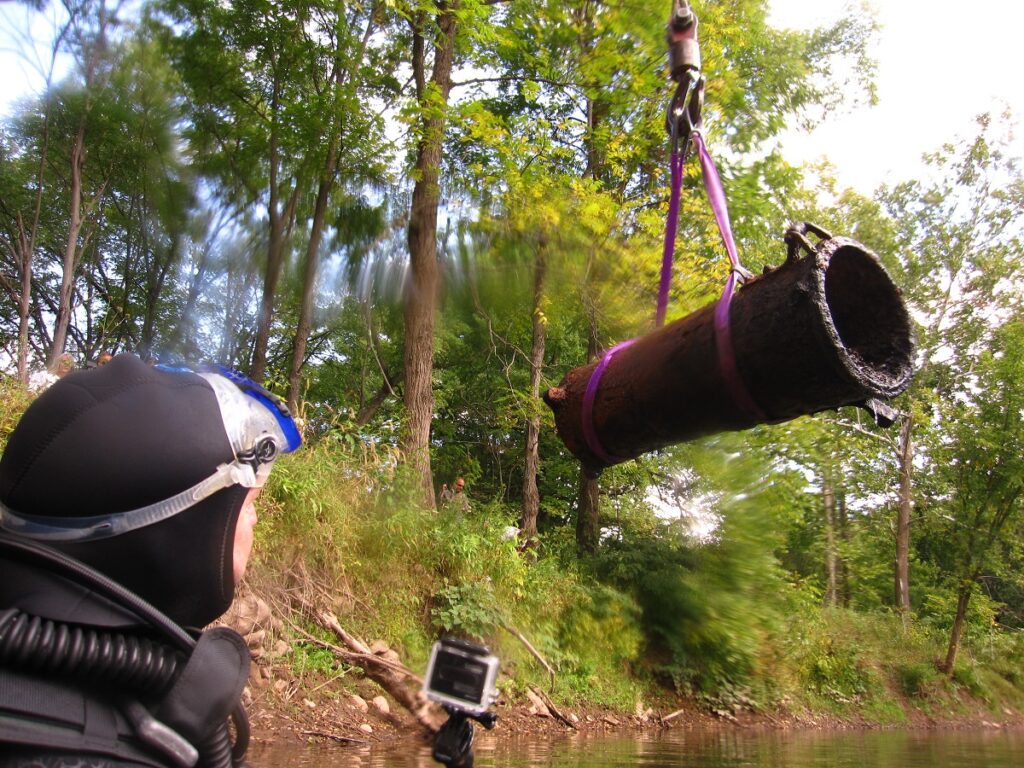
When a fallen steam locomotive was pulled from the waters of Loyalsock Creek in 1906, photos of the wreck showed the engine missing its smokestack; but no one ever noticed this.
Not until John Smithkors found that smokestack lying in the creek more than 100 years later.
It was July 2013, and Smithkors had decided to scuba-dive at the spot of the wreck, just east of the Route 87 bridge in Hillsgrove.
“I knew the history of it,” recalls the Dushore resident, who lived in Hillsgrove at the time. Having worked in the woods as a youth, Smithkors knew that lumber-laden rail-cars often carried chains, hooks, tools and other equipment. “If that train went off the bridge,” the diver told himself, “there’s gotta be something down there that they would not have recovered.
“But I didn’t expect to find anything like that.”
In fact, Smithkors first thought the sizable, silt-covered relic was a culvert. But why, he wondered, would a culvert be lying so far from the road? And why upstream? And more important: Why was it tapered, with flanges where something had broken off?
Rather than disturb the artifact, Smithkors finished his dive and phoned his brother, who pulled up photos of the engine’s extraction and noticed the missing smokestack.
A PIECE OF HISTORY
What the pair had stumbled onto was a well-known piece of Sullivan County history: Nicknamed “The Dinky in the Drink,” the accident involved a Climax B steam locomotive on a long-gone narrow-gauge railroad bridge. It was hauling 21 cars of lumber—but the Hillsgrove span failed to support this heavy load because it was in the process of being dismantled. After plunging into the creek, the water-logged engine was hauled out and restored, continuing in service until 1949. Thanks to Smithkors, its missing smokestack now resides in the Sullivan County Historical Museum.
But that took a lot of effort.
To begin with, even after talking with his brother, Smithkors still wasn’t certain what he’d found; so he went back into the water for some GoPro footage, then took that to the railroad museum in Strasburg, PA, where a similar Climax engine stands on display.
“That’s when I knew what I had,” the excited diver recalls.
Yet despite Smithkors’ certainty and interest, it was more than a year before the smokestack found its way to a showcase.
The diver’s first thought was that he could probably get it out and take it home—“put it out in my front yard and put a mailbox on it,” he jokes. “But I didn’t want that—I wanted to protect it; this is Sullivan County’s history.”
After all, if he kept it for himself, what would happen to the relic once he passed on—especially if it never got authenticated?
CALLING IN THE LAW
“The thought process also went to, ‘Who actually owns that?’” Smithkors recounts. “The center of the creek is a property line. I wouldn’t want anybody coming onto my property and taking something that’s mine.”
Eventually, he contacted a lawyer, who determined that because Loyalsock Creek is a commercial waterway, any artifacts found there belong to the State of Pennsylvania. So with the help of Sullivan County Historical Museum’s Melanie Norton, Smithkors submitted a three-page, 1100-word application to PA’s Bureau of Historic Preservation. In June 2014, they received an official permit to extract the relic.
But that process was even more complicated:
It involved permission from two local landowners along the creek; a pair other divers working with Smithkors; inflatable airbags wrapped around the smokestack; a boom truck to hoist it from the water; and Adam Jenkins, a Philadelphia expert in metal preservation who insisted the smokestack be instantly placed into a large trough of the same creek water it came out of.
“If we exposed it to air, it would deteriorate rapidly,” Smithkors explains.
“WHAT A SIGHT THAT WAS”
The inflatable bags were a bit of a bust, as the 40-inch smokestack turned out to weigh nearly 400 pounds; plus, it was filled with wet silt and muck. Nonetheless, the three divers finally got it scooted down to where the truck could reach it.
“What a sight that was, when that actually came out of the water,” Smithkors tells On the PULSE. “It was just a beautiful thing after all that work.”
Additional help was provided by science teachers and students from Sullivan County High School; they not only attended the extraction, but also measured pH in the water, which was treated with lye over a period of three months before Jenkins deemed the relic fit for removal from its bin.
Students then assisted him in coating the smokestack inside and out with a thin layer of inorganic wax—a process that required the item first to be heated with a propane torch.
But once it had been transported to the museum in a foam cradle built by the students, how would it be displayed?
MAKING A CASE FOR IT
Here’s where Norton picks up the story:
“My husband and I had gone to Sayre to see a car show, which happened to be in the parking area of their historical society—which was also open that day,” the museum volunteer recounts. “So I wandered in because I really didn’t care about the cars.”
Asking a docent about the museum’s handsome display cases, she learned that the man who made them was actually present in the building that day.
As Norton urged him to consider a case for the smokestack, “Finally he said, ‘I will do it on two conditions. I will only charge you for the material, which is the wood and glass—which, by the way, turned out to be $211; that was the only expense we had in this entire project, because of so many people’s gifts.”
“His other condition was that he was retiring, and this was to be his last display case. He said, ‘You can tell no one my name.’”
And Norton closes this account of her Sayre visit with a quiet but firm resolution: “I’m upholding that request.”
She does add, however, that this unnamed craftsman also created a step for the floor around the case—so visitors can look right down into the smokestack.
SATISFYING THEIR CURIOSITY
Norton says some come just to see this particular artifact; others know nothing about “The Dinky in the Drink”—in which case, photos and explanatory blurbs help “satisfy a curiosity they didn’t know they had.”
She is especially gratified when young people make a connection to the past through this display.
“For kids to get a concept of how things have come about before they were even born, things that don’t exist today, they have more interest and more curiosity than the general public would think.” And that’s important, says Norton.
Because, she explains, “If you don’t save the past, you can mess up the future.”




